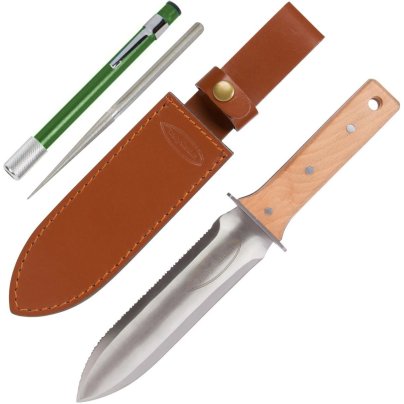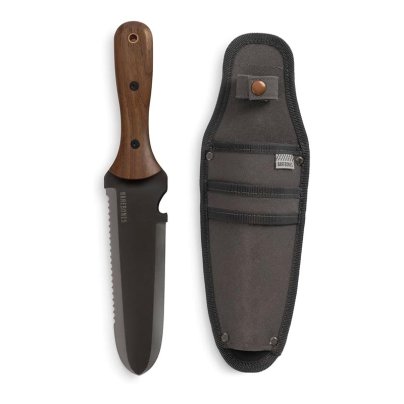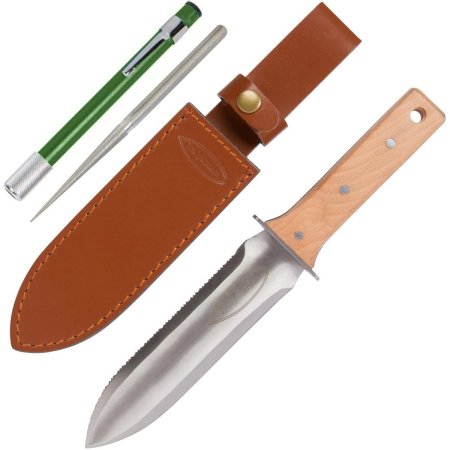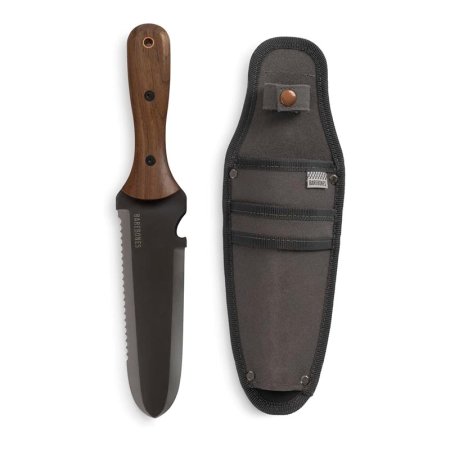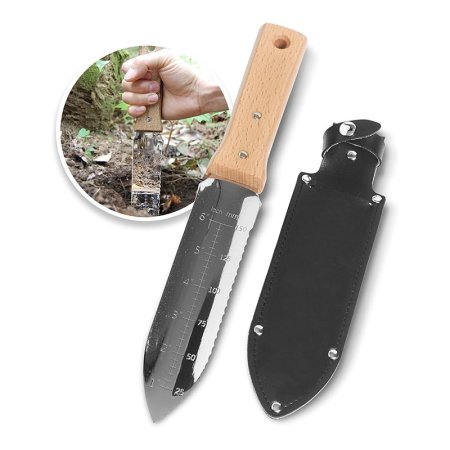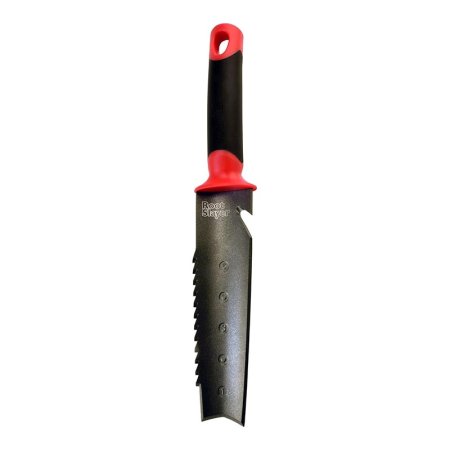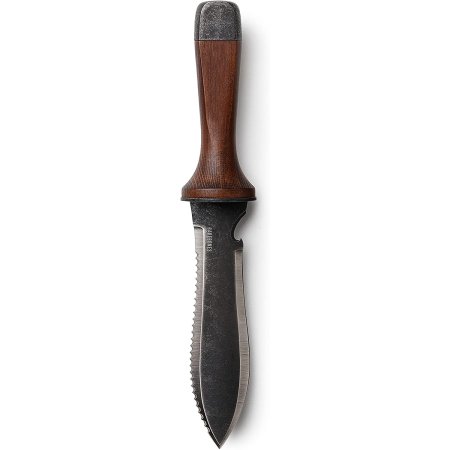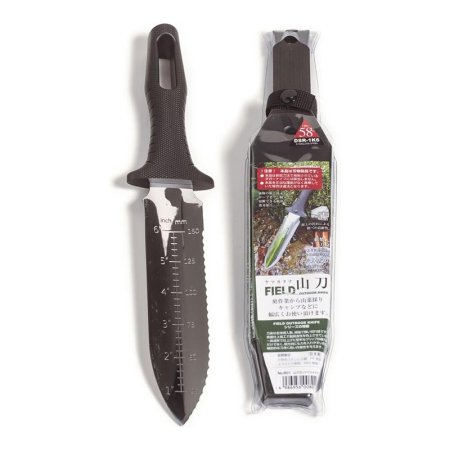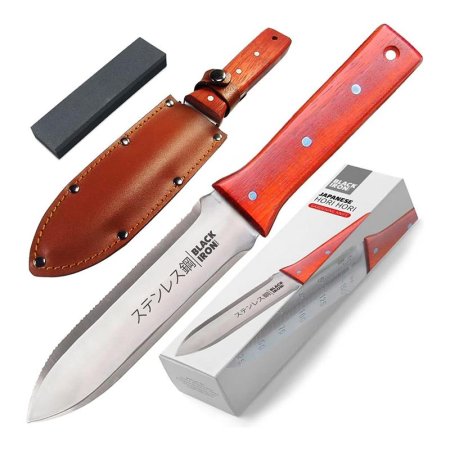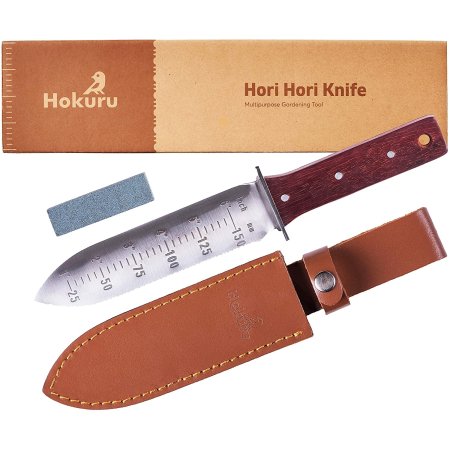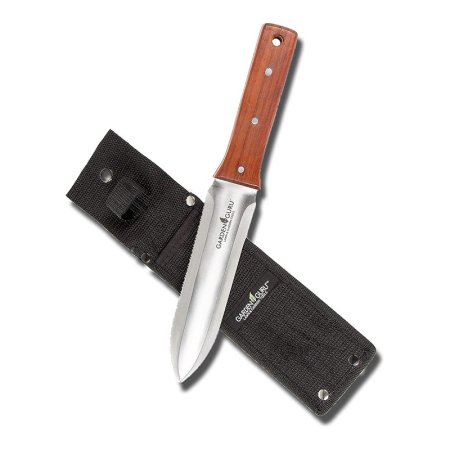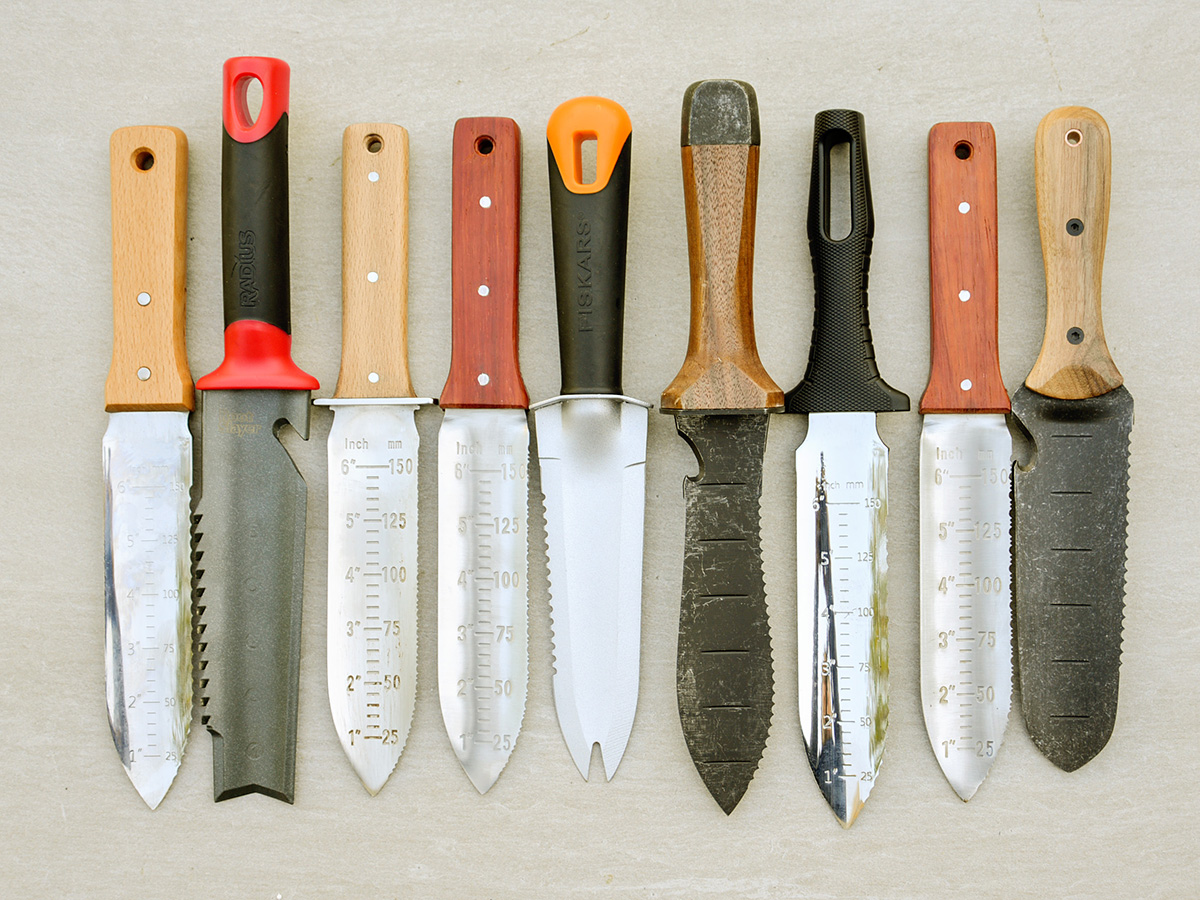
We may earn revenue from the products available on this page and participate in affiliate programs. Learn More ›
Originating in Japan, the hori hori knife is a multipurpose gardening tool used for digging, cutting, and weeding. A few qualities set hori hori knives apart from other garden knife tools, but not all are made equally. To weed out the weaker options and highlight the best hori hori knives on the market, we researched 27 hori hori knives from numerous manufacturers and tested the top 10 of them.
Also known as a “soil knife” or “weeding knife,” a hori hori knife has a pointed, concave steel blade that is sharp on both sides, often with one straight edge and one serrated edge. This design makes it a versatile tool for a wide range of tasks, such as weeding, planting, and dividing perennials. A high-quality hori hori knife is a long-lasting, incredibly useful tool for pretty much any gardener. Read on for our reviews of the best hori hori knives, including details on their construction as well as how each one fared in our gardens.
- BEST OVERALL: Truly Garden Hori Hori Garden Tool With Sheath
- BEST BANG FOR THE BUCK: Fiskars Big Grip Multipurpose Planting Knife
- UPGRADE PICK: Barebones Hori Hori Classic Knife
- BEST TRADITIONAL: Nisaku NJP650 Hori Hori Stainless Steel Weeding Knife
- BEST ERGONOMIC: Radius Garden Root Slayer Soil Knife
- BEST HEAVY-DUTY: Barebones Hori Hori Ultimate Knife
- BEST LIGHTWEIGHT: Nisaku NJP801 Yamagatana Japenese Knife
- BEST FOR PLANTING: Black Iron Hori Hori Garden Knife
- BEST FOR CUTTING: Hokuru Hori Hori Garden Knife
- BEST FOR WEEDING: Garden Guru Hori Hori Garden Knife
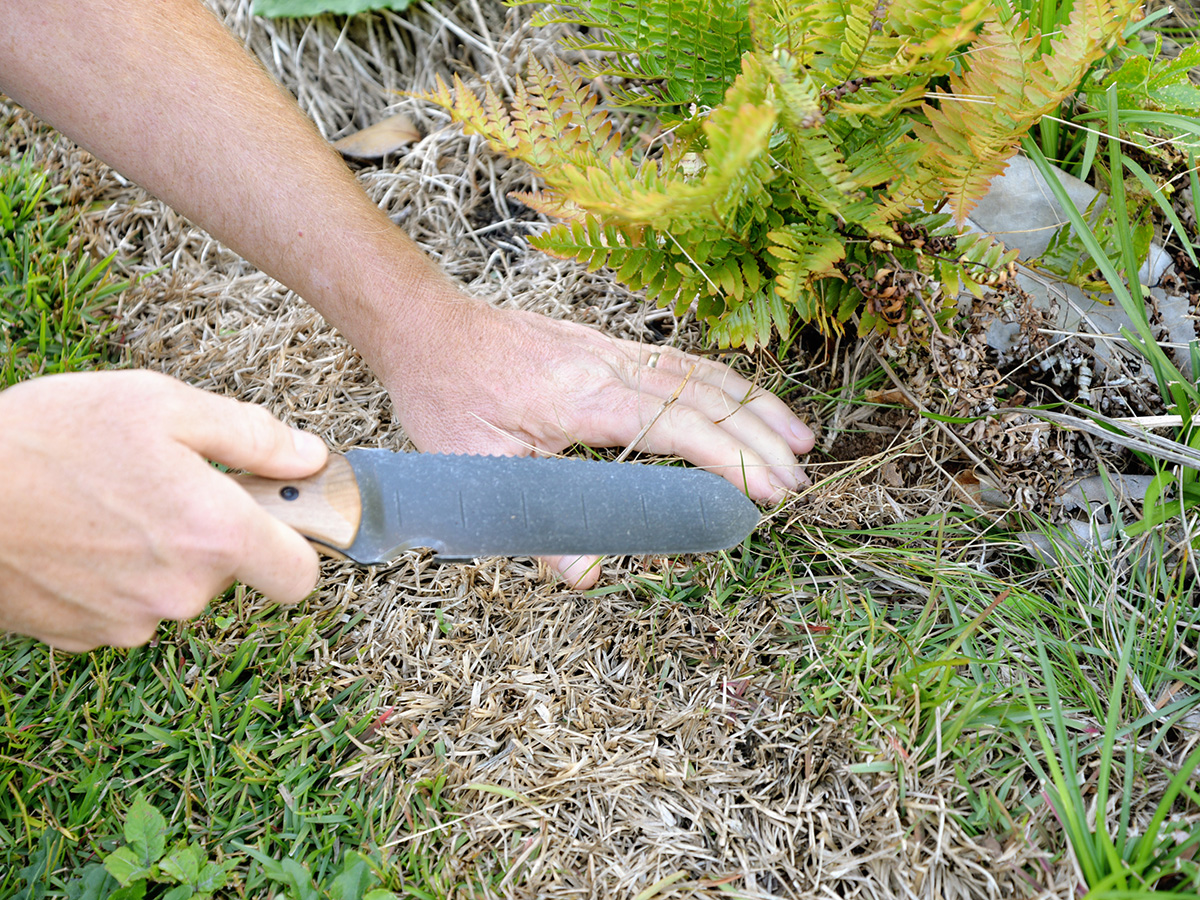
How We Tested the Best Hori Hori Knives
After an exhaustive search for the top candidates, we selected the following hori hori knives for testing based on the manufacturer’s specifications, price, and previous customer reviews. Our selections included both traditional Japanese-style knives and some unconventional designs. They run the full spectrum of prices to fit all budgets, too. Once we determined the picks, we designed our hori hori knife tests to evaluate each knife’s digging and cutting abilities, durability, and user comfort.
After recording the handle and blade dimensions, weight, and a short description of each hori hori knife in this guide, we used each one to complete the following tasks:
- Remove taproot weeds like dandelions and/or harvest taproot vegetables like carrots;
- Dig, divide, and transplant perennials with fibrous roots like hostas or daylilies;
- Cut garden twine; and
- Dig a 6-inch-long by 6-inch-wide hole in clay soil.
We scored each model on a rubric, with an eye toward overall effectiveness, perceived durability, and user comfort.
Our Top Picks
A good hori hori knife is durable, affordable, and comfortable to use. Our tested picks include a variety of choices, such as budget-friendly, heavy-duty, heirloom quality, and lightweight yet durable options. Read on to find the best pick for your budget and gardening style.
Best Overall
Truly Garden Hori Hori Garden Tool With Sheath
What We Like
- Includes a diamond sharpening rod to sharpen both flat and serrated edges
- Full-tang rustproof blade holds up to the rigors of serious gardening
- Attractive beechwood handle with a smooth, natural finish
- Competitive price point for dependable quality
What We Don’t Like
- Bulky scabbard is not very comfortable to wear on a belt while working
Product Specs
- Material: Stainless steel and beechwood
- Length: 12 inches
- Accessories: Leather sheath and sharpening rod
This Bob Vila Approved product carries our brand’s highest level of recommendation.

Bob Vila Approved recognizes the household and DIY products that impressed us most in our real-world testing and that exemplify core values of the Bob Vila brand, including craftsmanship, innovation, and value for the dollar. Winners of this designation come recommended by our professional review team and are personally approved by Bob Vila.
Like other knives, hori hori knives benefit from the occasional sharpening, which helps the knife maintain its weed-hacking abilities. Some knives include a sharpening block to make it easy to keep the straight-edge side sharp. For even more utility, the Truly Garden hori hori garden tool includes a diamond sharpening rod, which allows users to sharpen both the straight edge and serrated edge of the knife. To keep the knife protected in between uses, this model also comes with a leather sheath that has a convenient belt loop.
Great accessories aren’t the only thing this knife set has going for it. It’s a durable, high-quality pick featuring a full-tang stainless steel blade, which extends through the beechwood handle and is held solidly in place by three steel rivets. Additional features include measurement markings and a handguard to prevent fingers from slipping past the handle. It also comes with a 5-year warranty.
The handle on the Truly Garden hori hori knife has a smooth, natural finish that makes it one of the most comfortable to use. In our tests, the blade was sturdy enough to prevent bending while levering in hard clay soil, but it was still light enough to work comfortably for hours at a time. It also had the sturdiest of all the leather scabbards in the group. We appreciated that it has a handguard, unlike some of the models we tested, but some of the other handguard designs were a bit more comfortable. Still, for the best all-around package for utility, durability, and working comfort at a reasonable price, we couldn’t find a better option.
Read our full review:Truly Garden Hori Hori Garden Tool With Sheath
Get the Truly Garden hori hori knife at Amazon or Truly Garden.
Best Bang For The Buck
Fiskars Big Grip Multipurpose Planting Knife
What We Like
- Lowest price of all the options we tested
- Unique forked-tip blade specially designed to remove tough taproot weeds
- Large and comfortable soft-grip handle with wide handguard
- Lightweight, corrosion-resistant head and plastic construction
What We Don’t Like
- Thin metal is liable to fail in heavy soil with lots of rocks or tough roots
- Does not include a blade cover or any accessories
Product Specs
- Material: Plated steel and plastic
- Length: 14 inches
- Accessories: None included
Inspired by the Japanese hori hori knife design, this garden knife from Fiskars is a more affordable alternative to similar options. It has a less traditional design, and its plastic handle makes it look more like the average gardening-center tool. However, because it has a concave design as well as straight and serrated edges, it’s still useful for all the same tasks a hori hori knife can handle.
The budget-friendly price comes with a few sacrifices in quality. This knife has a plated steel blade and a plastic handle instead of wood or bamboo. Although the materials aren’t top of the line, it still has attractive features. The blade has a forked tip that can help with weeding, and the plastic handle is larger than average with a soft-molded grip for extra comfort.
Despite its unorthodox design, in many ways, the Fiskars Big Grip was one of our favorites. We really liked the lightweight build and large rounded handle. It was very comfortable to work with, and the orange spot on the end of the handle made it easy to locate when we left it in the garden. But the thin metal blade became dull rather easily, and it bent when we were working in heavy soil. Even with those known issues, it’s a very good gardening tool for raised beds and container gardening. Just try to keep it out of rough, unbroken ground for best results.
Get the Fiskars hori hori knife at Lowe’s, The Home Depot, or Walmart.
Upgrade Pick
Barebones Hori Hori Classic Knife
What We Like
- Rugged construction with full-tang stainless steel blade and double-riveted walnut handle
- Flat knife edge and serrated knife edge with broad spear-point design
- Built-in twine cutter doubles as a bottle opener
- Heavy-duty molded nylon sheath; belt loop and belt clip included as carrying options
What We Don’t Like
- Expensive; nearly twice the average price among the knives we tested
- Does not include a knife sharpener for blade maintenance
Product Specs
- Material: Stainless steel and walnut wood
- Length: 12 inches
- Accessories: Heavy-duty nylon sheath, built-in twine cutter
Weighing in at a stout 12.8 ounces, the Barebones Classic comes equipped for any cutting, digging, planting, or prying task in the garden. The heavy-duty heat-tempered steel blade features a broad spear-shaped tip that works equally well for transplanting and seed drilling. The flat blade includes a built-in twine cutter at its base that can double as a bottle opener in a pinch. Opposite the flat blade is perhaps the sharpest and most capable serrated blade we tested. The walnut handle perfectly wraps around the full tang, with a slightly incurved profile before flaring out near the hilt.
Another standout feature is the heavy-duty nylon sheath. Unlike the clunky leather and plastic models in our test group, this one is molded into an arc profile so that the blade can be smoothly inserted and withdrawn without snagging. And it came with both a belt loop and a belt clip for whatever carry method works best on a given day.
It was expensive and heavy, and it might be a bit tiring for extended use in some circumstances, but we really enjoyed using this knife nonetheless. We never felt as though we needed to be particularly careful to avoid damaging it because it was so sturdily built. It didn’t bend under the heaviest prying, and the blade retained its edge surprisingly well given the gravelly soil in some areas. The twine cutter worked like a charm, even after some serious transplanting, and it even helped us pop open a couple of cold beverages at the end of the day.
Get the Barebones Classic hori hori knife at Amazon or Barebones Living.
Best Traditional
Nisaku NJP650 Hori Hori Stainless Steel Weeding Knife
What We Like
- Traditional Japanese design and materials; made in Japan
- Double-riveted stainless steel blade with 1-inch and 5-millimeter gradient markings
- Includes a protective sheath with a belt loop for easy, hands-free carry
- Simple no-frills design and competitive price point for budget-conscious shoppers
What We Don’t Like
- Does not come with a protective handguard
- Partial-tang design exposes the handle to greater stress, which could lead to breakage
Product Specs
- Material: Stainless steel and wood
- Length: 12.5 inches
- Accessories: Leather sheath
Hailing from the hori hori knife’s country of origin, the Nisaku NJP650 is the best option for those looking for an authentic hori hori knife. Forged in Japan by artisans, the NJP650 features high-quality stainless steel and a traditional wooden handle.
Like most hori hori knives available today, this one features both a straight and serrated edge to tackle an assortment of gardening tasks, whether it’s planting bulbs or chopping through roots. Measurement markings on the blade make it simple to monitor depth while digging. A faux-leather sheath with a convenient belt loop is included to protect the knife when it’s not in use. With the versatile, no-frills design and high-quality materials, the Nisaku NJP650 brings it back to traditional basics in the best way.
The NJP650 offered an excellent balance between lightweight agility and durable functionality. It weighs 10 ounces, making it the third lightest among our test group, but it measured 12.5 inches long, which tied for the fourth longest hori hori knife. We liked the feel of the chunky handle, even though the finish was a bit less refined than our top pick. We used this knife somewhat carefully in the most demanding work settings because of its partial-tang construction. On top of that, the blade flexed with hard leverage, so we didn’t want it to bend permanently. Even so, we really liked the feel and design of this model, which we think would make an ideal pick for veggie, herb, and flower gardeners.
Get the Nisaku NJP650 hori hori knife at Amazon, The Home Depot, or Nisaku.
Best Ergonomic
Radius Garden Root Slayer Soil Knife
What We Like
- Very comfortable handle; generously proportioned with a soft grip
- Unique blade design with aggressive ripsaw edge, twine cutter, and wide V-tip
- Blade includes a 5-inch depth gauge with markings at 1-inch intervals
- Durable construction of powder-coated enameled steel and plastic
What We Don’t Like
- Blade coating blunts the sharp edges; must be partially ground off for best results
Product Specs
- Material: Powder-coated enameled carbon steel and plastic
- Length: 13.5 inches
- Accessories: None included
Some of us experience hand and wrist fatigue when gripping a tool handle that is too short, narrow, oddly shaped, or slippery. The Radius Garden Root Slayer provides the perfect antidote with its round, grippy, and generously proportioned handle. The contemporary soil knife design works much like a traditional hori hori knife, yet it looks anything but.
This model comes equipped with a powder-coated enameled carbon-steel blade paired with a molded plastic handle. It measures 13.5 inches long in total with a generous 6-inch handle, and it weighs just over 10 ounces. The blade includes an aggressive ripsaw edge on one side with a flat blade and twine cutter on the other. The blade tip culminates in a wide V-shaped notch designed to push through tough roots.
We had a real love-hate relationship with the Radius Garden Root Slayer. On one hand, we truly appreciated the comfortable handle, which topped all others in our opinion, and we liked the overall design of the tool. On the other hand, the blade’s coating was something of a nightmare. Right out of the box, the sharp edges were completely powder-coated, so they were as blunt as if there were no “edge” whatsoever. In order to actually cut anything, we had to manually remove the coating by using a grinder to reveal the edges. That process took way more time and effort than we liked, but afterwards, the blade was excellent.
Get the Radius Garden hori hori knife at Amazon, Lowe’s, or Walmart.
Best Heavy-Duty
Barebones Hori Hori Ultimate Knife
What We Like
- Heavy-duty stainless steel blade with built-in twine cutter/bottle opener
- Rugged walnut handle with flared handguard and steel pommel
- S-curved blade increases blade edge length and makes it easier to cut through tough materials
What We Don’t Like
- Premium price point for one of the toughest knives in our test group
Product Specs
- Material: Stainless steel and walnut wood
- Length: 13.125 inches
- Accessories: None included
A hori hori knife is already a multipurpose tool, but the Barebones Hori Hori Ultimate adds even more useful features. Featuring a high-quality build, this knife has a stainless steel blade with one straight side and one serrated side. The concave blade includes measurement markings and is mounted in a beautiful walnut handle that not only looks rugged and sleek, but also has a contoured design to fit comfortably in hand.
Some design perks add more utility to this knife. At the base of the blade, there is a small notched section, which functions as both a twine cutter and a bottle opener. With so many uses, this knife is a good pick for a range of outdoor activities, including gardening, fishing, and camping. Some retailers sell the knife and sheath separately, while others offer it as a bundle. We think it’s worth grabbing a sheath to keep this knife well protected.
Another rugged offering from Barebones, the Hori Hori Ultimate proved nearly indestructible in our garden tests. We used the steel pommel handle to hammer garden stakes, and the S-curved blade increased cutting power, making it ideal for slicing through tough roots. We liked the feel of the handle, which is more rounded than most, and we noted that it had a flattened side so that it would fit properly into a sheath (even though we didn’t get one with a sheath). It was the heaviest model we tested at 16 ounces, but it could be the right blade for those who tend to give their tools a beating.
Get the Barebones Ultimate hori hori knife at Amazon, Barebones Living, or Knife Works.
Best Lightweight
Nisaku NJP801 Yamagatana Japanese Knife
What We Like
- Lightweight build and comfortable rounded handle minimize hand and wrist fatigue
- Blade retains its sharpness well, even after demanding digging and cutting
- Molded composite handle and stainless steel provide impressive resistance to the elements
- Heavy-duty plastic belt sheath protects the blade and the carrier
What We Don’t Like
- Blade narrows where it connects to the handle, creating a weak point prone to bending
Product Specs
- Material: Stainless steel and plastic
- Length: 13 inches
- Accessories: Plastic sheath
Those who spend lots of time in the garden can appreciate reliable tools that don’t weigh them down. The Nisaku NJP801 Yamagatana garden knife is made with a durable stainless steel mid-tang blade and a molded plastic handle, and the result is outstanding durability and lightweight comfort.
The handle fits well in a wide range of hand sizes, and it features a flared handguard that was much more comfortable than those with flat steel guards. The blade features smooth and serrated blades and a depth gauge marked in 1-inch and 5-millimeter increments. For safe and convenient carrying, the NJP801 comes with a heavy-duty plastic sheath.
We really enjoyed working with the Nisaku NJP801. It felt comfortable in our hands, and the blade proved to be tough enough to retain its sharp edge after digging in rocky soil and chopping through tough roots. However, it was not as resistant to bending as some of the other knives we tested. The point where the blade connects to the handle is much narrower than the rest of the knife, allowing it to bend while under strain in heavy soil. This one is super sharp and built to last, but it’s not ideal for the heaviest digging tasks.
Get the Nisaku NJP801 hori hori knife at Amazon, The Home Depot, or Nisaku.
Best for Planting
Black Iron Hori Hori Garden Knife
What We Like
- Thick, full-tang stainless steel handle with 1-inch and 5-millimeter depth gauge
- Triple-riveted hardwood handle for added durability
- Kit includes a heavy-duty leather sheath and a two-sided sharpening stone
- Value priced compared to similar models that we tested
What We Don’t Like
- Blocky handle with no handguard; felt less refined than others in the test group
Product Specs
- Material: Stainless steel and wood
- Length: 12.25 inches
- Accessories: Leather sheath, 2-sided sharpening stone
When it comes to planting, the best hori hori knife holds up to heavy clay and gravelly soil, resists bending under significant leverage, and offers an accurate and easy-to-read depth gauge for reference. The Black Iron hori hori is a great example.
This knife weighs just over 10 ounces, making it one of the heavier tools in our test. The full-tang stainless steel blade features smooth and double-serrated edges as well as a depth gauge marked at 1-inch and 5-millimeter increments. The hardwood handle is triple-riveted to the blade for added durability. The kit includes a heavy-duty leather sheath and a sharpening stone with fine- and medium-grit surfaces.
While the overall construction of the Black Iron Hori Hori proved up to any garden task, we especially liked using it like a trowel or transplanter. It dug well, and leverage was not a problem. The handle was a bit chunkier and not as well refined as a few of the others in the group, and it didn’t have a handguard between the blade and handle, so it was not quite perfect. But it was also one of the less expensive models we tested. In short, this is a rugged and capable tool offered at a value price.
Get the Black Iron hori hori knife at Amazon or Attican.
Best for Cutting
Hokuru Hori Hori Garden Knife
What We Like
- Highly corrosion-resistant stainless steel blade retains its sharpness extremely well
- Full-tang design gives the knife excellent stability and durability for tough jobs
- Decay-resistant wooden handle with a protective steel handguard
- Compound/double-serrated blade slices effortlessly through twine and tough roots
What We Don’t Like
- Simple handle is blockier and less ergonomic than some other options
Product Specs
- Material: Stainless steel and wood
- Length: 12.3 inches
- Accessories: Leather sheath and sharpening stone
When it comes to choosing the right hori hori knife, durability and ease of use are often top of mind. Several features make Hokuru’s hori hori garden knife an excellent choice for the average gardener, starting with its heavy-duty stainless steel blade with two sharp edges. Whether it’s cutting garden twine, opening bags of mulch, or slicing through tough roots, this blade is equipped to handle the task.
Made from high-quality stainless steel that won’t rust or corrode over time, the Hokuru hori hori knife is built to last. The blade has a straight edge and a serrated edge, and it extends into a full tang through the handle, held firmly in place by three metal rivets—a blade design meant for heavy-duty digging and cutting. Measurement markings add more utility to this sturdy knife.
This pick also features a wooden handle in the traditional design of Japanese hori hori knives. Besides the attractive look, the knife’s small protective handguard enhances its safety. It also comes with a small sharpening stone and a thick leather sheath with a belt loop.
In our tests, the Hokuru hori hori kept a sharp edge while dividing bunches of hostas and daylilies. Then, after we used it to dig through tough clay soil in preparation for a new bed for transplants, the knife cleanly sliced open the garden soil bags. Since it comes equipped with a sharpening stone, it was easy to hone it between tasks. We also appreciated the included leather sheath to protect both the blade and our hands, but we would have liked it even more had it been equipped with a storage sleeve for the sharpening stone.
Get the Hokuru hori hori knife at Amazon or Walmart.
Best for Weeding
Garden Guru Hori Hori Garden Knife
What We Like
- Sturdy, stainless steel blade with 1-inch and 5-millimeter depth gauge
- Full-tang design provides support and stability, resists bending
- Triple-riveted hardwood handle for durability; smooth, rounded finish for comfort
What We Don’t Like
- The handle only has a modest flare where it meets the blade, and it lacks a handguard
- Flimsy nylon sheath rather than sturdy leather
Product Specs
- Material: Stainless steel and hardwood
- Length: 12.25 inches
- Accessories: Nylon sheath
With a comfortable and long-lasting build, this hori hori knife from Garden Guru is another appealing option for all types of gardeners. It features a rust-resistant stainless steel blade with a full tang. Thanks to its serrated side and straight side, it can tackle heavy-duty activities like digging through roots or sawing small branches without wobbling. The markings on the blade make it easy to measure while working, too.
The blade’s full tang extends through the triple-riveted hard rosewood handle, which is as sturdy as it is beautiful. The handle has a comfortable grip and is decay-resistant for long-term use. This knife includes a woven nylon sheath with a belt loop that protects the knife to some degree, but it’s usually better to upgrade to a leather sheath.
This knife weighed about 0.75 ounces less than several others in our test that were otherwise very similar in design and materials. The difference in weight came down to a slightly thinner blade and the lack of a steel handguard. This lighter-weight tool felt better balanced for working with a horizontal grip, such as for shallow weeding and cultivation. The blade was just as tough and sharp as the others, so shoppers need not be concerned about durability. The only true weak point was the flimsy nylon sheath, which is fine in the short term but will likely need to be replaced at some point.
Get the Garden Guru hori hori knife at Amazon or The Home Depot.
Jump to Our Top Picks
What to Consider When Choosing the Best Hori Hori Knives
The best hori hori garden knives can make light work out of a variety of gardening tasks. Finding the best hori hori knife is much less difficult when the search abides by a few key criteria. When shopping for a Japanese garden knife, consider the blade material and length, the handle, and any included accessories that can make it easier to use and maintain the knife.
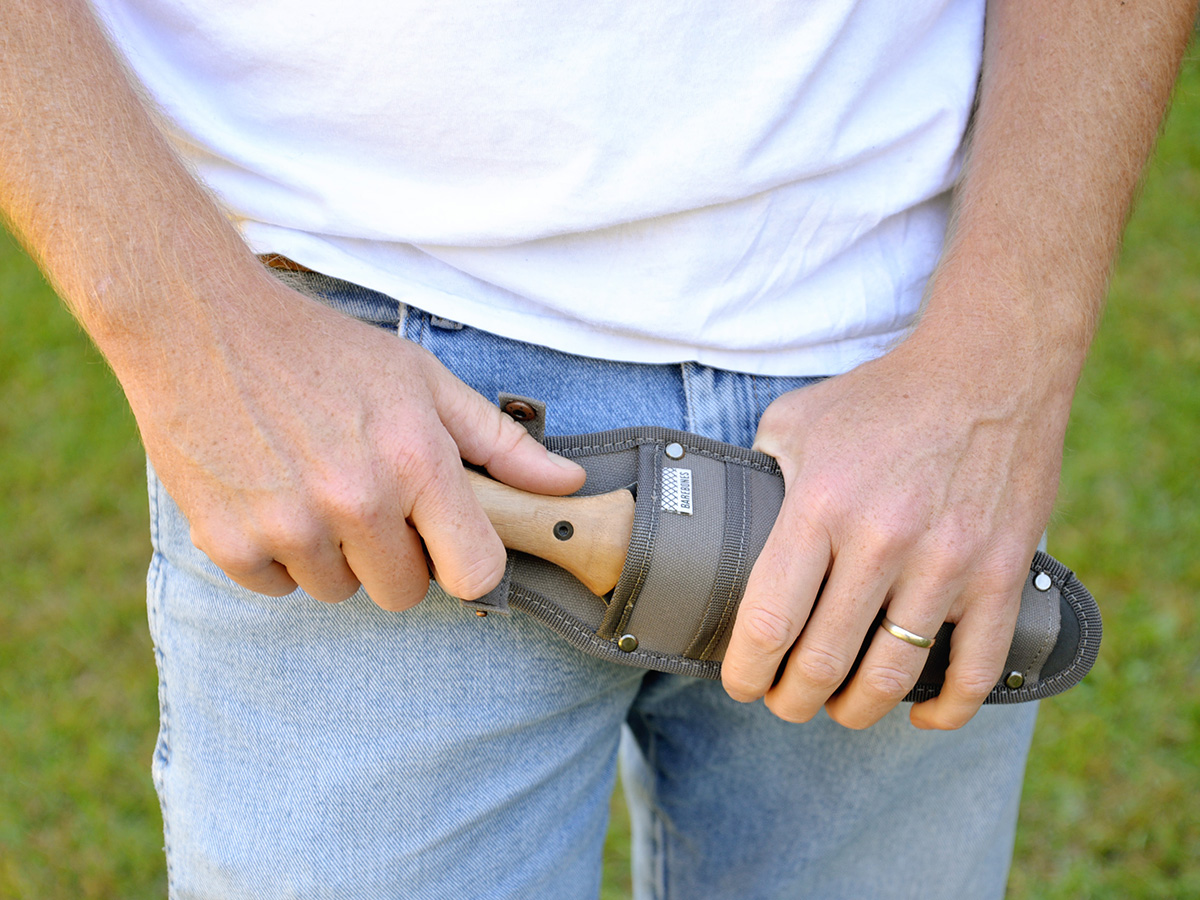
Blade Material and Length
All hori hori knives have a concave blade for digging, but the knife edges can vary. Most have one straight edge and one serrated edge, while some have two straight edges. The former is a more versatile pick, allowing the tool to be used as a trowel, knife, and small saw. Often, the blade also includes measurement markings to gauge depth when digging or planting.
Blade material can vary, with higher-quality materials offering better rust resistance and durability. High-quality stainless steel is usually the best pick, and that’s usually what reputable brands offer. Cheaper knives sometimes use lower-quality steel or aluminum that can rust and dull over time.
Hori hori knives are rather short in terms of length. The blade is usually around 7 inches long, and the entire knife, including the handle, is typically between 11 and 13 inches long. Look for a length that suits the particular job requirements; shorter knives are more nimble and easier to carry, while longer knives have a longer cutting surface.
Handle
A good hori hori knife handle has a durable, balanced feel. Traditionally, this Japanese garden knife has a wood or bamboo handle, but plastic handles are also available. An ergonomic design with a rounded profile makes the handle more comfortable to grip and work with, especially during long gardening sessions.
Wood and bamboo handles are attractive, long lasting, and comfortable. Cheaper knives tend to come with plastic handles, which can break down over time. For shoppers who opt for a plastic handle, a nonslip rubber grip can make the knife safer and more comfortable to use.
A high-quality Japanese weeding knife should come with a handle that is riveted to the tang of the blade (the part of the blade that extends into the handle). A full-tang blade extends to the butt of the handle, making these knives the most durable option, while partial-tang blades only extend partway into the handle. Some less expensive (and less durable) knife blades are welded to the handle and don’t have any tang at all.
Many hori hori knives are designed with little to no bolster or finger guard. It’s important to keep this in mind when using the knife, taking care not to let any fingers accidentally slip past the handle.
Accessories
A sheath is a useful accessory to have for both safety and storage. For even more utility, look for a sheath with a belt clip to make it safer to carry the knife around the garden.
High-quality sheaths are made from thick leather, which keeps the blades protected and safely covered. Fake leather and plastic sheaths won’t do much to protect the blade, and they tend to break down over time.
Like any knife, hori hori knives will need occasional sharpening. Some models come with a whetstone or sharpening rod so that gardeners can sharpen the knife themselves.
FAQs
A hori hori knife can be a useful tool for any gardener, especially those looking for a low-effort and affordable tool. Because of its design, a Japanese gardening knife is extremely useful for a range of tasks from tackling tough weeds to handling more precise work. Read on for some answers to common questions about this practical gardening tool.
While a hori hori knife is not a necessity, most gardeners won’t regret adding one to their tool belt. A hori hori knife can combine the functions of a trowel, knife, and small saw to handle multiple gardening tasks with one affordable tool.
Hori hori knives aren’t as sharp as a chef’s knife, for example, but they are still sharp enough to require caution while working. Users will want to avoid running their hands across the blades to prevent cuts.
Yes, hori hori knives are a safe garden tool to use. Just use common sense—their blades are still sharp.
A hori hori knife is an extremely versatile garden knife tool. Gardeners can use it for digging, cutting, sawing, and weeding.
A well-made hori hori knife can last up to a decade. High-quality steel and a riveted wood or bamboo handle are signs of good craftsmanship and are predictors that the knife will likely last.
“Hori hori” is a Japanese onomatopoeia that mimics the sound of digging into soil, which is the main use of this tool.
Meet the Tester
Mark Wolfe is a writer and product tester with a background in the nursery and landscaping industries. For more than 20 years he mowed, edged, planted, pruned, cultivated, irrigated, and renovated beautiful landscapes. Now he tests and writes reviews about the latest outdoor power equipment, hand tools, lawn care products, and other outdoor-living goods.
Additional research provided by Jasmine Harding.
